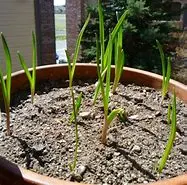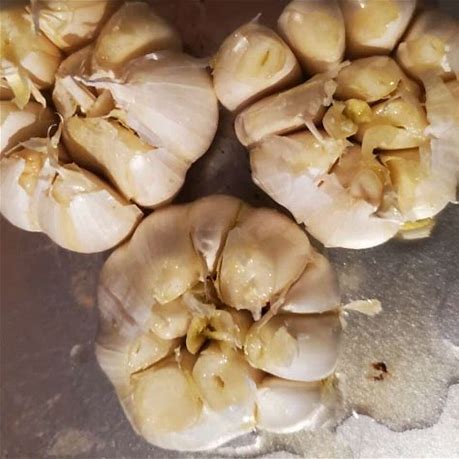Growing Gorgeous Garlic In Great Containers

Growing gorgeous garlic takes a little more skill but we break down when to plant garlic, how to plant garlic in gorgeous containers, and the diseases, pests, and companions of garlic. We even dig into how to roast garlic.
Pick The Right Soil for Growing Garlic
Growing garlic is easy if you know when and how to grow it. Garlic is acidic and prefers soil with 5.8 level Ph. (This is one plant you don’t want to eat if you have acid reflux.) Add several handfuls of compost to the soil, make sure it drains well and crumbles easily.
How To Plant and Care For Garlic
Garlic is usually planted in the fall so the roots develop before the first frosts. Then growing garlic has the entire winter to rest and grow roots until it shoots out leaves in the spring. If you live in an area with a long summer, you can plant in the spring, in early March but you may not have large cloves at the end of the season. Use about 6″ of mulch if you plant in the fall, to protect the plants. The link is to my post about mulching your fall garden. Growing garlic during the winter does not need water. Some gardeners put 7-10-10 fertilizer below where the garlic cloves (seeds) will rest.
Plant garlic cloves 2″-4″ apart about 2″ deep. Growing garlic requires you to place the clove with the wide root side down and the pointy end up. Plant about 10″ apart. When spring encourages new growth, cut off any flowers that appear and give the growing garlic a good supply of fertilizer. You may want to fertilize again when the garlic bulbs start to swell about May in most regions. If leaves begin to yellow add a nitrogen rich fertilizer. Water every 3-5 days, and if summer is especially hot and dry, give a deep water down to a foot every 10 days.
Direct Seed or Transplant
Garlic is almost always grown from garlic cloves. In fact, you probably have seen your garlic cloves sprout out on the kitchen countertop. It is best to get cloves from a nursery or seed catalog as the garlic in stores may have an inhibitor sprayed on them making them harder to grow. Also, you may have varieties unsuitable for your area.
Diseases and Pests Of Garlic
Garlic has very few pests and, in fact, is a good companion plant to other vegetables because it repels a lot of pests. The only disease is a fungus called white rot which is difficult to kill once it infests garlic. This requires the garlic to be rotated for several years away from the place it was infected because the spores of white rot live for several years.
Companion Plants Of Garlic
Growing garlic is usually used for other plants more than garlic since it repels a lot of pests. However, garlic does well in an area with fruit trees, dill, beets, or kale and spinach. Growing garlic likes a lot of nitrogen in the soil.
Harvesting Garlic

Garlic normally matures in June-August. Yellowing leaves at this time, mean the plant is dying because the bulbs are mature. The tops should just be yellowing and ready to fall over. The best way to check if the garlic is ready is to pull up one plant. If the bulb is big, compact, and the outer papery covering thick, the bed is ready to be harvested. The outer skin layer will be thin and too papery when pulled too soon. If left too long in the soil, the cloves will break apart. Carefully dig up the bulbs using a gardening fork. Do not hank them out by the leaves. In fact, leave the leaves and the roots on the bulbs until they are completely dried out. Put them in a dry, airy, shady spot to dry out for two weeks. A great way is to hang them upside down in bunches of 4-5 bulbs, making sure all sides get good ventilation. After a few weeks the bulbs should be dry and ready for storage.
How To Use Garlic
After a few weeks drying, garlic roots should be hard and the cloves easy to crack apart. Trim the leaves and roots, leaving on the outer papery shell. Store garlic in a cool dry place about 40 degrees F. The flavor will improve as they continue to dry out. Do not store in a moist basement or refrigerator. They want cool but not moist areas.
Great Garlic Recipe
Roasted garlic has a surprising flavor and consistency. This is one of my favorite recipes and is a great spread on a French baguette. I got this recipe from Healthier Steps website.
How To Make Roasted Garlic Bulb?

- Preheat oven 400 degrees F. Remove the outer skin of the garlic bulb and discard.
- Trim about 1/4 inch off the top of the garlic,
- Place garlic on a piece of parchment paper and or foil paper.
- Drizzle olive oil on the top of the garlic.
- Cover garlic and bake for 40-50 minutes or until garlic is soft and golden brown.
- Remove garlic from oven and allow to cool. Sprinkle a little salt over roasted garlic then simply squeeze the base of the garlic to remove the soft flesh.
- Store garlic by placing it in a jar, cover with olive oil and refrigerate for no more than one week.
Conclusion
Growing garlic is more difficult than most plants since garlic has to be planted so it has cool weather for 4-8 weeks. It also needs plenty of fertilizer with heavy amounts of nitrogen in the soil. It is an acidic plant that likes moist soil and at least 6 hours of sun during the day. Harvesting garlic is more labor intensive because it needs to dry in an airy cool place for several weeks. The best part of growing garlic is there are few pests to content with. Finally, its worth the challenges of growing garlic in containers because it imparts a fantastic flavor to so many great dishes. Have you grown your own garlic? Please leave a comment in the form below.